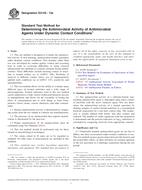Potrebujeme váš súhlas na využitie jednotlivých dát, aby sa vám okrem iného mohli ukazovať informácie týkajúce sa vašich záujmov. Súhlas udelíte kliknutím na tlačidlo „OK“.
ASTM E2149-13a
Standard Test Method for Determining the Antimicrobial Activity of Antimicrobial Agents Under Dynamic Contact Conditions (Includes all amendments And changes 10/27/2020).
Automaticky preložený názov:
Štandardná skúšobná metóda pre stanovenie antimikrobiálnu aktivitu antimikrobiálnych látok za dynamických podmienok styku
NORMA vydaná dňa 1.10.2013
Informácie o norme:
Označenie normy: ASTM E2149-13a
Poznámka: NEPLATNÁ
Dátum vydania normy: 1.10.2013
Kód tovaru: NS-44477
Počet strán: 5
Približná hmotnosť: 15 g (0.03 libier)
Krajina: Americká technická norma
Kategória: Technické normy ASTM
Kategórie - podobné normy:
Mikrobiologie obecně
Zkoušení vnějších vlivů a zkoušení ve vnějším prostředí
Anotácia textu normy ASTM E2149-13a :
Keywords:
antimicrobial, antibacterial, shake flask test, textile, ICS Number Code 07.100.01 (Microbiology in general), 19.040 (Environmental testing)
Doplňujúce informácie
| Significance and Use | ||||||
|
4.1 Chemically bonded, antimicrobial agents are not free to diffuse into their environment under normal conditions of use. This test method ensures good contact between the bacteria and the treated fiber, fabric, or other substrate, by constant agitation of the test specimen in a challenge suspension during the test period. 4.2 The metabolic state of the challenge species can directly affect measurements of the effectiveness of particular antimicrobial agents or concentrations of agents. The susceptibility of the species to particular biocides could be altered depending on its life stage (cycle). One-hour contact time in a buffer solution allows for metabolic stasis in the population. This test method standardizes both the growth conditions of the challenge species and substrate contact times to reduce the variability associated with growth phase of the microorganism. 4.3 Leaching of an antimicrobial is dependent upon the test conditions being utilized and the ultimate end use of the product. For example, water soluble antimicrobials will be prone to removal from the test surface using the method described in Section 4.4 This test method cannot determine if a compound is leaching into solution or is immobilized on the substrate. This test method is only intended to determine efficacy as described in 4.5 and subsequent portions of the method. 4.5 This test method is intended to evaluate antimicrobial agents that are not removed from the surface by the aqueous testing conditions, as evaluated by Section 4.6 The test is suitable for evaluating stressed or modified specimens, when accompanied by adequate controls. 1.1 This test method is designed to
evaluate the antimicrobial activity of non-leaching,
antimicrobial-treated specimens under dynamic contact conditions.
This dynamic shake flask test was developed for routine quality
control and screening tests in order to overcome difficulties in
using classical antimicrobial test methods to evaluate
substrate-bound antimicrobials. These difficulties include ensuring
contact of inoculum to treated surface (as in AATCC 100),
flexibility of retrieval at different contact times, use of
inappropriately applied static conditions (as in AATCC 147),
sensitivity, and reproducibility.
1.2 This test method allows for the ability to evaluate many different types of treated substrates and a wide range of microorganisms. Treated substrates used in this test method can be subjected to a wide variety of physical/chemical stresses or manipulations and allows for the versatility of testing the effect of contamination due to such things as hard water, proteins, blood, serum, various chemicals, and other contaminants. 1.3 Surface antimicrobial activity is determined by comparing results from the test sample to controls run simultaneously. 1.4 The presence of an antimicrobial that requires neutralization is determined by the post-test. 1.5 Proper neutralization of all antimicrobials must be confirmed using Test Methods E1054. 1.6 This test method should be performed only by those trained in microbiological techniques. 1.7 The values stated in SI units are to be regarded as standard. No other units of measurement are included in this standard. 1.8 This standard may involve hazardous materials, operations, and equipment. This standard does not purport to address all of the safety concerns, if any, associated with its use. It is the responsibility of the user of this standard to establish appropriate safety and health practices and determine the applicability of regulatory limitations prior to use. |
||||||
| 2. Referenced Documents | ||||||
|
Podobné normy:
Historická
1.6.2012
Historická
15.11.2011
Historická
1.12.2012
Historická
1.4.2012
Historická
1.3.2010
Historická
1.4.2012



 ASTM D5245-92(2012)..
ASTM D5245-92(2012).. ASTM D6831-11
ASTM D6831-11 ASTM D7847-12
ASTM D7847-12 ASTM E2180-07(2012)..
ASTM E2180-07(2012).. ASTM E2186-02a(2010)..
ASTM E2186-02a(2010).. ASTM E2196-12
ASTM E2196-12
 Cookies
Cookies
